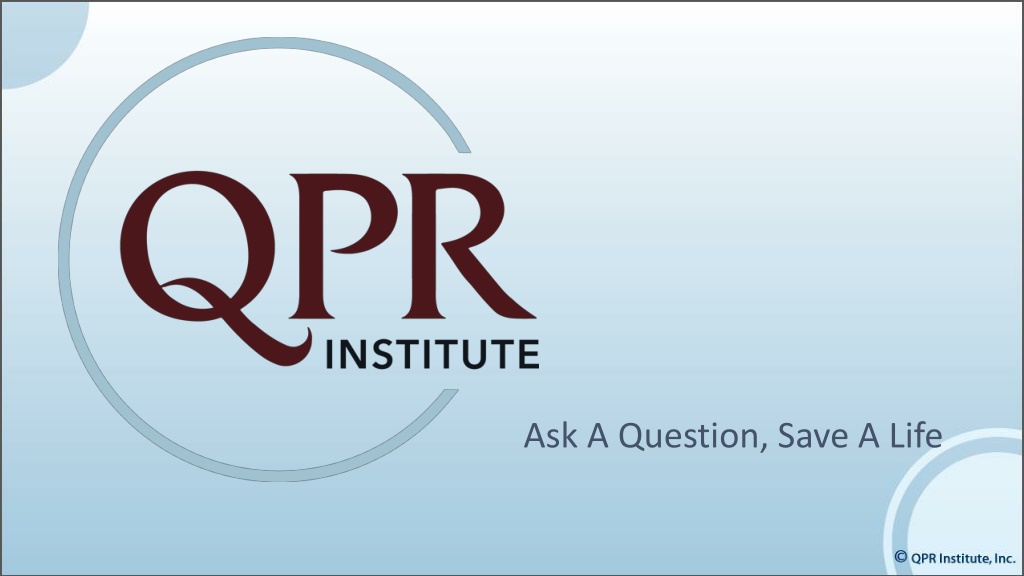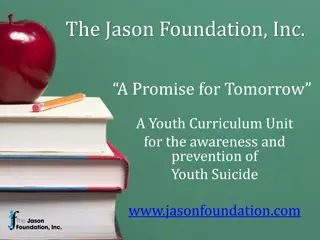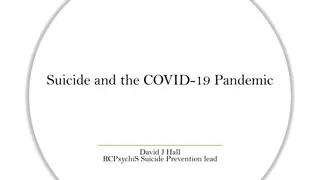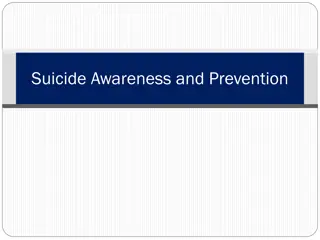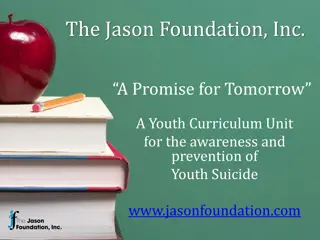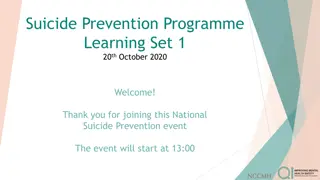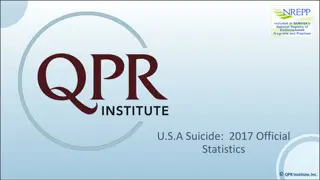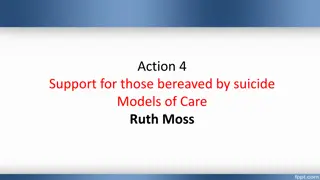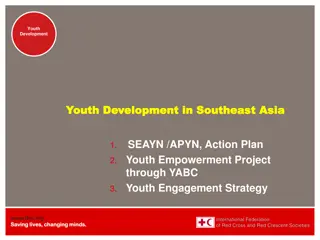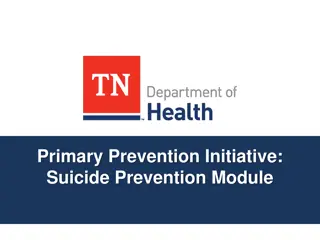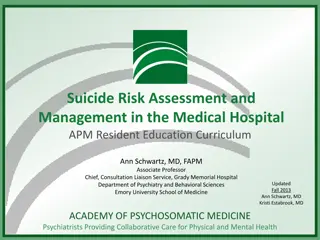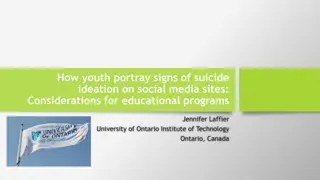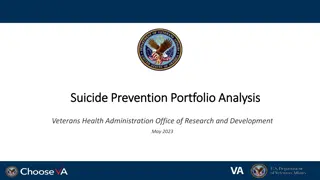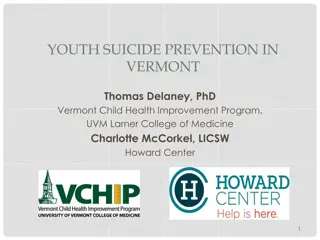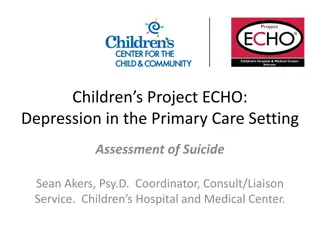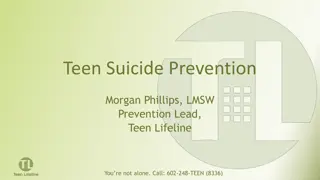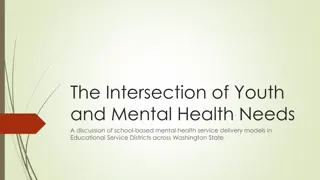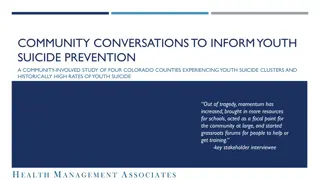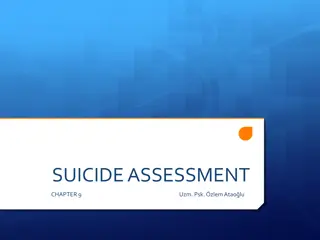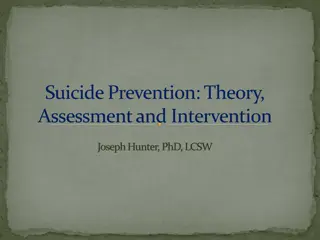Youth Suicide Overview: Understanding Risk and Prevention
Delve into the scope and impact of youth suicide in America and Washington State. Explore risk factors, prevention strategies, and key elements of the National Strategy for Suicide Prevention. Gain insights into interventions to reduce suicide attempts and completions, with a focus on the numbers and disparities affecting youth.
Download Presentation

Please find below an Image/Link to download the presentation.
The content on the website is provided AS IS for your information and personal use only. It may not be sold, licensed, or shared on other websites without obtaining consent from the author.If you encounter any issues during the download, it is possible that the publisher has removed the file from their server.
You are allowed to download the files provided on this website for personal or commercial use, subject to the condition that they are used lawfully. All files are the property of their respective owners.
The content on the website is provided AS IS for your information and personal use only. It may not be sold, licensed, or shared on other websites without obtaining consent from the author.
E N D
Presentation Transcript
Youth Suicide: An Overview Your Name Here Your Affiliation Here The QPR Institute (if you choose)
Learning objectives Describe the size and scope of the problem of youth suicide in America and in Washington State Identify evidence-based risk and protective factors Identify key elements of the National Strategy for Suicide Prevention Describe basic interventions for reducing suicide attempts and completions
Scope of the problem in the US, and over the past 12 months 15.8% seriously considered suicide 12.8% made a plan for suicide 7.8% attempted suicide one or more times 2.4% made a suicide attempt that lead to treatment nurse For 15-24 year olds, suicide was the 2nd leading cause of death in 2011 by a doctor or Source: 2011 Youth Risk and Behavior Survey
Scope of the problem in Washington An average of 2 youth between the ages of 10 and 24 die by suicide each week in Washington State. More than one in every 10 high school students reported having attempted suicide; nearly 1 in 6 students between the ages of 12-17 have seriously considered it. More than 30% of LGBTQ youth report at least one suicide attempt within the last year.* More than 50% of Transgender youth will have had at least one suicide attempt by their 20th birthday.* Youth suicides outnumber youth homicides. *Based on national statistics as Washington State does not specifically track suicide statistics for our LGBTQ and Transgender populations. * Source: WYSPP www.wspp.org.
Washington youth continued While most of the youth who die by suicide in Washington are Caucasian, the rate is highest among Native Americans, with approximately 20 deaths per 100,000. Reasons for this unacceptably high rate among Native American youth have been attributed to drug and alcohol abuse, historical trauma, and long-term disenfranchisement. For the latest rankings of youth suicide by state, gender, age and ethnicity in the US, go to www.suiciolodgy.org.
Numbers to remember Boys die 4.34 X as often as girls Girls attempt 3 X as often as boys Boys use firearms more and are more likely to die from an attempt Lethality of method contributes to outcomes 90% of youth who die by suicide are suffering from an Axis I mental disorder (mood disorder, substance abuse and often both).
Do the math in your school Of 1,000 students in your school this year: 159 will think seriously about suicide 13 will plan how to kill themselves 8 will make a suicide attempt 2 to 3 will make and attempt and receive medical care
Major Youth Risk Factors Mental illness Substance abuse Firearms in the household Previous suicide attempts Non-suicidal self-injury Exposure to friends/family members suicide Low self-esteem Source: see research/publication references slide
Major Youth Protective Factors Family and school connectedness Safe schools Reduced access to firearms Academic achievement Positive self-esteem Multiple sources: see reference list
Youth Suicide Prevention is all about Reducing risk factors and increasing protective factors
In summary, and while it is our most preventable death . More teenagers died from suicide than from cancer, heart disease, AIDS, birth defects, stroke, pneumonia and influenza, and chronic lung disease combined. Source: U.S. Public Health Service (1999)
Whats different now? The problem isn t going away If you ve lost a loved one you have a political voice A social movement has begun Based on well-argued public health research, Washington State passed HB 1336
The National Strategy Snapshot Objective and Goals Aims: Prevent premature deaths due to suicide across the life span Reduce the rates of other suicidal behaviors Reduce the harmful after-effects associated with suicidal behaviors and their impacts on others Promote opportunities and settings to enhance resiliency, resourcefulness, respect and interconnectedness for individuals, families and communities.
NSSP Major Goals 1. Promote awareness that suicide is a preventable public health problem 2. Develop broad support for suicide prevention 3. Develop and implement SP strategies for consumers of health services 4. Develop and implement SP programs 5. Promote means restriction
NSSP Major Goals 6. Implement training for recognition of at-risk behavior and delivery of effective treatment 7. Develop and promote effective clinical care 8. Improve access to services 9. Improve reporting in the media 10. Promote and support research 11. Improve and expand surveillance systems
Historical School-based Suicide Prevention Programs Educate teachers, school counselors, and parents about suicide warning signs Raise student awareness, encourage self-referral, train peers to recognize and refer Identify highest risk students through combination of screenings, multi-stage assessments, and education of school staff
Current Status Many youth-focused suicide prevention programs are available Too few of them have supporting research to establish that they are safe and effective Most include enhance resiliency, encouraging help-seeking, and education teachers, counselors, students and family in suicide warning signs and positive interventions.
Where to find programs Best single listing: Suicide Prevention Resource Center www.sprc.org Best Practice Registry Section I: Evidence-Based Programs (rigorous evaluation with positive outcomes) Section II: Expert and Consensus Statements (best knowledge summaries in the form of guidelines, protocols and expert opinion) Section III: Adherence to Standards (program content has been reviewed by experts and found to adhere to current program development standards)
Do these programs work? Evaluation challenges Operational definitions and methods of assessment vary widely Lack of consensus regarding warning signs or what should be taught Concerns regarding large group impacts Cannot randomly assign high risk kids to either participate in a prevention program or a control condition
More evaluation challenges No one wants to do research in their school or college as it suggests they have a problem Low base rates of completed suicide require huge samples to evaluate whether there is an impact on suicide completion
Major Barrier: Talking about suicide will encourage the behavior Not so! Studies now show that discussion of suicide with young people does not increase suicidal ideation or behaviors. Gould, MS, Marrocco, FA, Kleinman M, Thomas JG, Mostkoff K, Cote J, Davis, M. Evaluating iatrogenc risk of youth suicide screening programs: a randomized controlled trial, JAMA, 2005 Apr 6l 293 (13): 1635-43 Gould et al., JAMA, 2005 Bryan, C.J., Dhillon-Davis, L.E., & Dhillon-Davis, K. (2010). Emotional impact of a video-based suicide prevention program on suicidal viewers and suicide survivors. Suicide and Life-Threatening Behavior, 39, 623-632. Eynan, R., Bergmans, Y., Antony, J., Cutliffe, J.R., Harder, H.G., Ambreen, M . & Links, P.S. (2014). The effects of suicide ideation assessments on urges to self-harm and suicide. Crisis 35(2): 123-131.
Some things we do know.. In children and adolescents, the most frequently diagnosed mood disorders are major depressive disorder, dysthymic disorder, and bipolar disorder. In children & adolescents, an MDD episode lasts an average of 7-9 months. Majority of depressed young adults don t receive treatment. Untreated depression is the #1 cause of suicide. Depression is treatable.
Symptoms of youth depression Changes sleep patterns (either more or less) Changes in appetite (either more or less) Self-esteem (criticize themselves, feels criticism by others) Social Isolation Concentration Energy & Motivation Alcohol/substances
Symptoms continued.. Irritability (especially true of adolescents!) Worrying & brooding (fears of separation or reluctance to meet others) Somatic Complaints (stomachaches, headaches, etc.) Sadness & Tearfulness Less enjoyment of previously pleasurable activities Hopelessness, pessimistic outlook Thoughts of death, suicide, or self-harm
Shortest route to preventing the next suicide? 1. Remove alcohol by denying access 2. Remove firearms by denying access 3. Reduce distress by warm, compassionate, active listening and caring 4. Maintain contact during and after crisis 5. Access counseling and care by a well-trained, competent professional
References (Centers for Disease Control and Prevention, National Center for Injury Prevention and Control. Web-based Injury Statistics Query and Reporting System (WISQARS) [online]. [cited February 2012]. Available from www.cdc.gov/ncipc/wisqars) and Centers for Disease Control and Prevention, National Center for Injury Prevention and Control. Web-based Injury Statistics Query and Reporting System (WISQARS) [online]. [cited February 2012 Kaminski et al, J Youth Adol, 2010 Brent et al., J Am Acad Child Adol Psych, 1999. Eisenberg et al., J PED, 2007 Brent et al., J Am Acad Child Adol Psych, 1999 Grossman et al., JAMA, 2005 Beautrais, SLTB, 2004 Borowsky et al., Pediatrics, 2001 Nock et al., Psychi Res, 2006 Sharaf e al., JCAPN, 2009 Borowsky et al., Pediatrics,2001 Resnick et al., JAMA, 1997
Break Questions Answers Discussion
QPR Theory and Practice in School Settings QPR stands for Question, Persuade and Refer, an emergency mental health intervention that teaches lay and professional Gatekeepers to recognize and respond positively to someone exhibiting suicide warning signs and behaviors.
Why QPR? Each letter in QPR represents an ideaand an action step QPR intentionally rhymes with CPR another universal emergency intervention QPR is easy to remember Asking Questions, Persuading people to act and making a Referral are established adult skills Out of clutter, find simplicity Albert Einstein
QPR Theory Assumption: passive systems don t work - Those most at risk for suicide: - tend not to self-refer for treatment - tend to be treatment resistant - often abuse drugs and/or alcohol - dissimulate their level of despair - go undetected - go untreated (and remain at risk for suicide)
QPR Theory - Most suicidal people send warning signs - Warning signs can be taught - Gatekeepers can be trained to a) recognize suicide warning signs and, b) intervene with someone they know - Gatekeepers must be fully supported by policy, procedure and professionals in their community
QPR Theory Effective Gatekeepers: - Are alert to the possibility of suicide - Know suicide risk factors - Recognize symptoms of distress and depression - Recognize suicide warning signs - Know what to say, when to say it, and what to do
The QPR Chain of Survival (like CPR) 4 links 1. Early recognition of warning signs 2. Early application of QPR 3. Early referral to professional care 4. Early assessment and treatment Knowledge + Practice = Action
Seven Life-Saving Goals Detection of suicidal persons Active intervention Alleviation of immediate risk factors Accompanied referral Access to treatment Accurate diagnosis Aggressive treatment Ask the question, save a life.
QPR PREVENTION STRATEGY AWARENESS SURVEILLANCE DETECTION Suicidal Thoughts Suicidal Warning Signs Suicide Attempt Suicide injury or death INTERVENTION Perceived Insoluble Problem OPPORTUNITIES Question Refer Persuade Treat
A simple truth The person most likely to prevent you from taking your own life is someone you already know; the application of network theory to suicide prevention
Untrained Social Network Diagram 1 Coach School Nurse Scenario: Depressed 16-year-old student in crisis over poor school performance review, girlfriend leaving him and recent truancy Student in crisis School counselor Coded Clues No Clues Parents & Uncoded Clues Clear Verbal Threats Best Self-referral unlikely Pastor Friend Hotline call unlikely Intervention unlikely Girlfriend Source: Paul Quinnett, Ph.D., QPR for Suicide Prevention
Trained social network Diagram 2 Network Trained Note: girlfriend trained in this network. If everyone is training odds detection and survival are increased. Coach & staff School Counselor School Nurse Student assessed- suicide attempt averted School Counselor applies QPR QPR Intervention Teachers Question Asked Best Friend Parents Persuaded Depression/ alcohol screening Girlfriend Referral Completed Suicide attempt averted! Source: Paul Quinnett, Ph.D., QPR for Suicide Prevention
Highly Reliable School Leadership Policy & Procedure Culture of Safety Training matches level of duty Everyone is trained Training is mandatory Competency must be demonstrated Mental Health Specialists: Risk Assessment Training School Counselors, Nurses, Social Workers and Psychologists: Screening Training Everyone completes basic QPR gatekeeper training
To prevent the next youth suicide, who should be trained? Traditional gatekeepers: nurses, social workers, clergy, mental health professionals, 1st responders and others with a duty to preserve the health and safety of young people Non-traditional gatekeepers: teachers, advisors, administrative support staff, and anyone in frequent and/or strategic contact with potentially at- risk youth, e.g., coaches, scout leaders, mentors, and all adults who play a role in the life of a young person. PLUS: Anyone identified by the youth as someone important in his or her life whether through face-to-face relationships or Facebook or text or any other emerging form of communications to include best friends, family members, teammates, etc.
If it takes a village, do you live in one? Research has shown that humans belong to groups of roughly 150 people who they know on a first name basis. Among this group are friends, families, siblings, cousins, teachers, coaches, other students, and people the young person knows at work or play or through the internet. When in distress, troubled youth communicate to one or more persons in this group. If they send suicide warning signs, they will be sent to members of this social network. The more people trained in how to recognize and respond to these warning signs the better the odds the young person will get help and survive the crisis.
Hi! Im Joe and Im 16. Here s my community! We are 150 strong!
Hi again! Some people here can help me if I have problems.
Joe here! This is my village and everyone can help!
Finally.. We know the order of march We know who to train 1st, 2nd, and 3rd We know what to teach them We know where to teach them We have evidence that interventions work We have measures to monitor our outcomes We have leadership -- all we need is a go!
Contact Information Name Email Address www.qprinstitute.com Please visit the QPR Institute web site and download the free e-book: Suicide: the Forever Decision and share it widely ..
